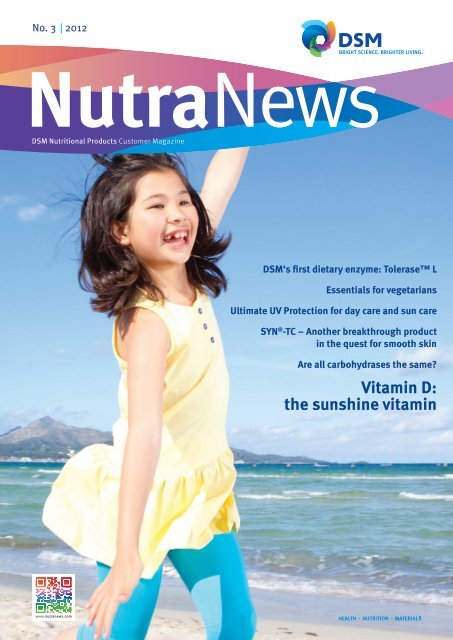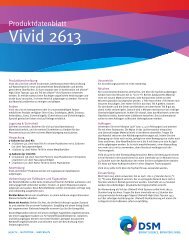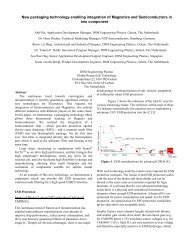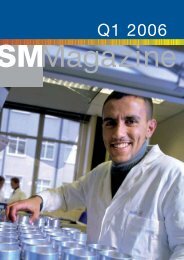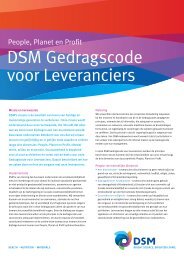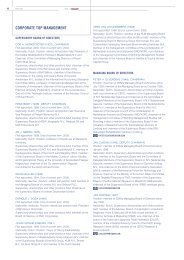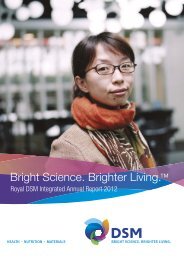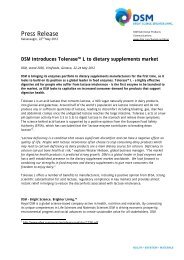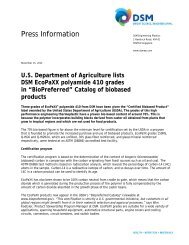NutraNews - DSM Nutritional Products newsletter 3/2012
NutraNews - DSM Nutritional Products newsletter 3/2012
NutraNews - DSM Nutritional Products newsletter 3/2012
Create successful ePaper yourself
Turn your PDF publications into a flip-book with our unique Google optimized e-Paper software.
No. 3 | <strong>2012</strong><br />
<strong>NutraNews</strong><br />
<strong>DSM</strong> <strong>Nutritional</strong> <strong>Products</strong> Customer Magazine<br />
www.nutranews.com<br />
<strong>DSM</strong>‘s first dietary enzyme: Tolerase L<br />
Essentials for vegetarians<br />
Ultimate UV Protection for day care and sun care<br />
SYN ® -TC – Another breakthrough product<br />
in the quest for smooth skin<br />
Are all carbohydrases the same?<br />
Vitamin D:<br />
the sunshine vitamin<br />
<strong>NutraNews</strong> | No. 3: <strong>2012</strong> 1
2<br />
Focus: Human Nutrition & Health<br />
<strong>DSM</strong> launches the first dietary<br />
enzyme: Lactose intolerance digestive<br />
aid, Tolerase L<br />
<strong>DSM</strong> launched the first dietary enzyme<br />
in its new health benefit platform<br />
‘Digestive Health’ at Vitafoods in Geneva<br />
in May this year. <strong>DSM</strong>’s aim is to serve<br />
dietary supplements manufacturers<br />
globally, capitalizing on increased<br />
consumer demand for products that<br />
support digestive health.<br />
Tolerase L is a highly effective<br />
digestive aid for people who suffer from<br />
lactose intolerance. It is an acid lactase<br />
that converts lactose, a milk sugar naturally<br />
present in dairy products, into glucose and<br />
galactose. Approximately half the world’s<br />
population are lactose intolerant and do not<br />
produce any or sufficient quantities of<br />
lactase. This leads to symptoms of<br />
discomfort including bloating, gas, diarrhea<br />
and abdominal cramps once the undigested<br />
lactose reaches the large intestine.<br />
Tolerase L acts at a low pH (optimum<br />
activity from 3.5 to 5.5) to digest lactose in<br />
the stomach and relieve these symptoms.<br />
The science behind acid lactase is supported<br />
by a positive opinion from the European<br />
Food Safety Authority (EFSA), which has<br />
concluded that “the lactase enzyme<br />
contributes to breaking down lactose”.<br />
Later this year Tolerase P will be<br />
launched. Phytase (P) is an enzyme that<br />
<strong>NutraNews</strong> | No. 3: <strong>2012</strong><br />
Quality for Life in action: <strong>DSM</strong>’s NUTRI-FACTS<br />
website recognized as an online provider of<br />
objective, high-quality health information<br />
Through <strong>DSM</strong>’s Quality for Life promise,<br />
we aim to be a reliable partner and industry<br />
member. This includes a dedicated<br />
commitment to sound nutrition science.<br />
This ambition was well illustrated in June <strong>2012</strong>,<br />
when www.nutri-facts.org was awarded the<br />
3 Milk<br />
3 Pasta<br />
3 Pizza<br />
3 Butter<br />
3 Doughnuts<br />
3 Bread<br />
3 Pancakes<br />
3 Ice cream<br />
3 Biscuits<br />
3 Cereal<br />
helps the body absorb iron, zinc, calcium,<br />
magnesium and phosphorus from cereal and<br />
legume-based foods. Phytase does this by<br />
breaking down the molecule phytate which<br />
is rich in those foods. It releases the minerals<br />
and makes them bioavailable for the<br />
human body.<br />
HONcode certification, the highest and most<br />
trustworthy ethical standard for medical and<br />
health-related information available on the<br />
internet. The code of conduct of the Health on<br />
the Net Foundation, a non-governmental<br />
organization internationally known for its work<br />
in the field of health information ethics,<br />
evaluates the quality of a website in terms of<br />
how useful, objective and transparent its<br />
information is for health professionals and the<br />
general public.<br />
Typical applications for Tolerase P are<br />
Base-of-the-Pyramid nutrition, breakfast<br />
supplements and cereals, and pasta.<br />
Wouter Nieboer<br />
Global Business Manager<br />
– Human Nutrition & Health<br />
wouter.nieboer@dsm.com<br />
NUTRI-FACTS offers easily accessible<br />
information on the latest scientific news and<br />
established facts about micronutrients in<br />
multiple languages. Launched in 2010, the<br />
website is now visited by 19,000 individual<br />
users from the food industry, healthcare<br />
professionals, and media representatives each<br />
month. In addition, NUTRI-FACTS has<br />
successfully established itself on Facebook<br />
(with more than 6,000 fans and friends) and<br />
Twitter (with about 2,000 followers).
Essentials for vegetarians Latest news<br />
As part of our ongoing effort to deliver<br />
solutions that help create brighter lives,<br />
<strong>DSM</strong> has introduced the “Essentials for<br />
Vegetarians” Health Benefit Solution<br />
platform. Essentials for Vegetarians allows<br />
<strong>DSM</strong> to address a strong customer desire<br />
for solutions that reach the broadest<br />
possible range of consumers and address<br />
the needs of a large and growing global<br />
consumer segment.<br />
With an estimated 1.4 billion consumers<br />
considered either vegetarian or semivegetarian,<br />
this platform puts <strong>DSM</strong> out front in<br />
serving the needs of a large consumer base<br />
that has been the biggest single segment of<br />
food product launches over the past two years.<br />
<strong>DSM</strong> offers solutions designed specifically for<br />
the nutritional needs of vegetarians as well as<br />
addressing the even larger opportunity<br />
represented by customers who wish to make<br />
their products more inclusive for all<br />
consumers, including vegetarians.<br />
There are three primary points of focus for<br />
vegetarians within the <strong>DSM</strong> portfolio. One is<br />
life’sDHA – <strong>DSM</strong>’s proprietary omega-3<br />
brand produced from algae. This provides the<br />
Human Nutrition & Health<br />
Events<br />
FI South America<br />
September 18 — 20, São Paulo, Brazil<br />
www.fi-events.com.br/fi<br />
Intl. Food Technology Summit & Expo<br />
September 26 — 27, Mexico DF, Mexico<br />
FI Asia<br />
October 3 — 5, Jakarta, Indonesia<br />
http://fiasia-indonesia.<br />
ingredientsnetwork.com/<br />
Hi Japan<br />
October 3 — 5, Tokyo, Japan<br />
www.hijapan.info<br />
Intl. Food Technology Summit & Expo<br />
October 24, Buenos Aires, Argentina<br />
SupplySide West<br />
November 5 – 9, Las Vegas, NV<br />
XVI Congreso de la Sociedad<br />
Latinoamericana de Nutrition (SLAN)<br />
November 11 – 16, Cuba<br />
FI Europe<br />
November 13 – 15, Frankfurt, Germany<br />
http://hieurope.ingredientsnetwork.com<br />
Resveratrol conference<br />
December 5 – 7, Leicester, UK<br />
only reliable long-chain PUFA solution for<br />
vegetarian consumers around the globe and fits<br />
perfectly with our desire to expand the life’sDHA<br />
brand to consumers around the world.<br />
In addition <strong>DSM</strong> will introduce Tolerase P<br />
– a phytase enzyme solution that breaks down<br />
phytate in cereals and legume-based foods.<br />
By breaking apart the phytate in these foods,<br />
trapped minerals are freed for better<br />
absorption in the human body. Tolerase P<br />
also protects minerals added to these foods,<br />
providing manufacturers an important new<br />
dimension for combating mineral deficiency<br />
around the world.<br />
Finally, <strong>DSM</strong> produces more animal-free forms<br />
across our ingredient portfolio than any other<br />
manufacturer in the industry. This important<br />
differentiator enables our customers to make<br />
their key products appeal to a wider base of<br />
consumers, including the growing vegetarian<br />
population around the world.<br />
Doug Brown<br />
Global Marketing<br />
Manager Dairy<br />
doug.brown@dsm.com<br />
<strong>DSM</strong> to acquire Ocean<br />
Nutrition Canada to<br />
expand its <strong>Nutritional</strong><br />
Lipids growth platform<br />
<strong>DSM</strong> announced today that it has entered<br />
into a definitive agreement with Clearwater<br />
Fine Foods and funds managed by<br />
Richardson Capital to acquire Ocean<br />
Nutrition Canada for a total enterprise<br />
value of CAD 540 million. Subject to<br />
customary conditions, the transaction is<br />
expected to close in H2 <strong>2012</strong>.<br />
<strong>DSM</strong> announces new<br />
research revealing how a<br />
B vitamin can help lower<br />
blood pressure<br />
Research conducted by the University of<br />
Ulster and published in the American<br />
Journal of Clinical Nutrition, reveals a new<br />
link between vitamin B2 and curbing high<br />
blood pressure.<br />
Around 10% of the UK population has a<br />
specific genetic factor which can lead to<br />
high blood pressure. The new study from<br />
the Northern Ireland Centre for Food and<br />
Health (NICHE) reveals that vitamin B2<br />
can successfully lower blood pressure<br />
within this genetically at-risk group, to an<br />
extent that could cut the risk of stroke<br />
death by as much as 30%.<br />
<strong>DSM</strong> presents dietary<br />
vitamin intakes using ‘traffic<br />
lights’ which suggest<br />
widespread inadequacies<br />
in the Western World<br />
A new assessment published in the<br />
British Journal of Nutrition suggests that<br />
three quarters of the population in<br />
Germany, the UK, and the USA, does not<br />
meet the dietary intake<br />
recommendations of the respective<br />
countries for a number of essential<br />
micronutrients. Based on large-scale<br />
population-based national dietary intake<br />
surveys, scientists at <strong>DSM</strong> evaluated data<br />
using a traffic light system to measure<br />
actual intakes against national<br />
recommendations in the UK, Germany,<br />
the Netherlands and the USA.<br />
Further information can be found on<br />
www.dsmnutritionalproducts.com<br />
<strong>NutraNews</strong> | No. 3: <strong>2012</strong> 3
Ultimate UV Protection for day care<br />
and sun care<br />
Health organizations around the world are<br />
relentless in reminding the consumer of the<br />
detrimental effects of excessive sunbathing<br />
and the importance of using minimum SPF<br />
15 sunscreen products. The avoidance of<br />
sunburn is widely accepted and is, of<br />
course, also strongly personally motivated<br />
as it prevents discomfort. Preventing skin<br />
redness (erythema) is seen by most<br />
consumers as a proof that their protection<br />
strategy has worked. Moreover there is<br />
even a belief that an absence of visible<br />
damage means there is no further damage<br />
to the skin.<br />
Unfortunately this is wrong. UV rays are quietly<br />
causing DNA mutations, oxidative stress and<br />
immunosuppression from the moment we<br />
expose ourselves to sunlight and up to the<br />
point when our skin shows the first discernible<br />
warning signals. The smallest UV light dosage<br />
necessary to cause sunburn is called 1 Minimal<br />
Erythemal Dosage (MED). As long as the<br />
radiation intensity stays below sunburn, it is<br />
called “sub-erythemal”, and energies can be<br />
measured in parts of an MED.<br />
Evaluation of human skin biopsies after UV<br />
exposure is a helpful tool to identify suberythemal<br />
UV damage. By this experimental<br />
set-up we have shown that even at 0.6 MED UV<br />
light substantial DNA damage occurs, in<br />
particular when the sub-erythemal dosage is<br />
4<br />
Focus: Personal Care<br />
<strong>NutraNews</strong> | No. 3: <strong>2012</strong><br />
accumulated over several days – quite a<br />
common situation during the summer months.<br />
In fact, a 20-minute summer lunch break in<br />
Paris could drive some areas in an exposed<br />
facial site of a skin type 2 person to 0.7 MED,<br />
and 30 min to slight sunburn, even.<br />
There is a definite need to counteract this daily<br />
exposure with at least a moderate SPF of 15 to a<br />
level below 0.1 to 0.2 MED.<br />
Taking the typically applied amount of a SPF 15<br />
facial cream into account, a dosage of 0.1–0.2<br />
MED would be reached in about two hours. At<br />
that time sub-erythemal UVA damage also<br />
plays a role in adding significant aging stress to<br />
the dermal tissue. Therefore a daily care formula<br />
needs adequate UVA protection as well.<br />
Particularly for facial care it makes sense to go<br />
beyond the EU recommended UVA-PF of 3:1.<br />
What about beach holidays? Consumers seek to<br />
spend time in the sun, and they require a<br />
significantly higher level of protection. Easily<br />
repeated sub-erythemal dosages would be<br />
reached when using only the recommended<br />
minimum of a SPF 15 sunscreen – often<br />
consumers experience even sunburn. A<br />
minimum of SPF 30 is therefore required.<br />
To address all customer needs more than this<br />
has to be considered, however. The sunscreen<br />
formula must offer appealing features in order<br />
Breakthrough<br />
product plus<br />
other exciting<br />
innovations<br />
that the consumer enjoys applying it. Only this<br />
will ensure a sufficient application amount on<br />
the skin. The consumer has only a sensory<br />
endpoint to stop applying the product!<br />
Therefore as much effort as goes into the<br />
selection of the right UV filter combination<br />
should also go into optimizing the texture.<br />
This makes for ultimate UV protection.<br />
Dr. Jürgen Vollhardt<br />
Competence Manager R&D Personal Care<br />
juergen.vollhardt@dsm.com<br />
Personal Care<br />
Events<br />
IFSCC<br />
October 15 – 18, Johannesburg,<br />
South Africa<br />
www.ifscc<strong>2012</strong>.co.za/coschem/index.cfm<br />
Sepawa Congress<br />
October 23 – 25, Fulda, Germany<br />
www.sepawa.de/index/sepawa_<strong>2012</strong>/<br />
sepawa_business.html<br />
Suppliers Day at SEQC<br />
October TBC, Madrid, Spain<br />
In-Cosmetics Asia<br />
November 6 – 8, Bangkok, Thailand<br />
www.in-cosmeticsasia.com<br />
Formulate SCS<br />
November TBC, UK
SYN ® -TC – Another breakthrough<br />
product in the quest for smooth skin<br />
On 1 July <strong>2012</strong>, <strong>DSM</strong> globally launched its<br />
breakthrough new peptide complex<br />
SYN ® -TC which has a rapid skin-smoothing<br />
action. This innovative product further<br />
extends the successful SYN ® -Peptides<br />
product range, creating yet more choice for<br />
consumers, who greatly value the beauty of<br />
smooth skin.<br />
The group of naturally occurring proteins known<br />
collectively as collagen is the most abundant<br />
protein in skin. It is the main component in<br />
connective tissue and anchors the epidermis<br />
(the outermost layer of skin) to the dermis,<br />
which in turn protects the body’s subcutaneous<br />
tissues. Collagen therefore makes a major<br />
contribution to the appearance of the skin,<br />
producing the firm and smooth look desired by<br />
consumers. Collagen levels in the body<br />
naturally decrease with age, however. The use<br />
of state-of-the-art skin care ingredients helps to<br />
deploy the unique capacities of collagen<br />
against the signs of premature skin ageing.<br />
Various types of collagen exist. Skin care<br />
products have traditionally focused primarily on<br />
collagen I, using ingredients to stimulate this<br />
form of collagen to smooth the skin. Other<br />
types of collagen, however – most notably<br />
types III, IV, VII, and XVII – also make a major<br />
contribution to the functionality of the skin.<br />
SYN ® -TC makes use of three tailor–made<br />
peptides (short polymers of amino acid<br />
monomers linked by peptide bonds) to increase<br />
in vitro the formation of undamaged, stable and<br />
homogenous collagen types in the skin. These<br />
best-in-class synthetic peptides have been<br />
formulated and combined to achieve a visible<br />
benefit for smoother skin and an overall<br />
improved young looking skin appearance.<br />
Extended in vitro studies using macro<br />
photographs and computer-based<br />
3-dimensional skin imaging have confirmed a<br />
visible benefit in only 28 days.<br />
SYN ® -TC is the result of <strong>DSM</strong>’s consumer-driven<br />
approach to generate added value for its<br />
customers by offering an exciting new cosmetic<br />
ingredient with rapid action for skin smoothing.<br />
Mathias Gempeler<br />
Senior Global Marketing Manager Skin Care<br />
mathias.gempeler@dsm.com<br />
<strong>NutraNews</strong> | No. 3: <strong>2012</strong> 5
6<br />
Focus: Animal Nutrition & Health<br />
<strong>DSM</strong>’s Optimum Vitamin Nutrition<br />
concept to appear as e-book<br />
Following the appearance of the 12 th<br />
edition of <strong>DSM</strong>’s Optimum Vitamin<br />
Nutrition (OVN) levels in<br />
February of this year, this work has<br />
been made available as an e-book in<br />
cooperation with 5M publishing.<br />
Electronic copies in PDF format can<br />
be purchased and downloaded from<br />
www.optimumvitaminnutrition.com<br />
Independent nutritionists from around the<br />
world and nutritionists from <strong>DSM</strong> reflect<br />
scientific advances on animal performance<br />
and production, as well as changing<br />
industry conditions.<br />
Latest news<br />
<strong>DSM</strong> expands Italian<br />
premix offering with<br />
products for the homemixing<br />
industry<br />
<strong>DSM</strong> is pleased to announce the<br />
acquisition of the Italian animal health<br />
and nutrition premix specialist Cilpaz<br />
S.r.l. through its Italian operation Istituto<br />
delle Vitamine S.p.A. This acquisition is<br />
a further milestone in the<br />
implementation of <strong>DSM</strong>’s strategy <strong>DSM</strong><br />
in Motion: driving focused growth.<br />
Continued value growth within the<br />
company’s Nutrition cluster of businesses<br />
is a key component of this strategy.<br />
<strong>DSM</strong> to acquire Tortuga<br />
to strengthen animal<br />
nutrition business<br />
<strong>DSM</strong> announced that it has entered into<br />
a definitive agreement to acquire<br />
Tortuga Companhia Zootécnica Agrária<br />
(Tortuga) in an all cash transaction for a<br />
total enterprise value of about €465<br />
million (BRL 1,160 million). Depending<br />
on the actual <strong>2012</strong> EBITDA result, an<br />
adjustment in the purchase price up to<br />
a maximum enterprise value of about<br />
€490 million can be made, based on<br />
the same EBITDA-multiple. Subject to<br />
customary conditions, the transaction is<br />
expected to close in Q1 2013.<br />
Further information can be found on<br />
www.dsmnutritionalproducts.com<br />
<strong>NutraNews</strong> | No. 3: <strong>2012</strong><br />
The resulting book, Optimum Vitamin Nutrition<br />
– in the Production of Quality Animal Foods,<br />
comprises seven chapters that will provide a<br />
phantastic reference for the many nutritionists,<br />
veterinarians and other technicians around the<br />
world involved in animal nutrition.<br />
The book will also provide a useful basis for<br />
future research into the as-yet undiscovered<br />
See you at EuroTier <strong>2012</strong>!<br />
This year <strong>DSM</strong> will again be participating<br />
at EuroTier, the world’s leading exhibition<br />
for animal husbandry.<br />
At EuroTier 2010, some 140,000 visitors –<br />
approximately 24,000 of them from outside<br />
Germany – came to gather information about<br />
machinery and equipment, genetics, farm<br />
inputs and services for modern animal<br />
husbandry as well as potentials in the field of<br />
bioenergy and local energy supply. More than<br />
1,900 exhibitors were present.<br />
ways in which vitamins can play a role in<br />
providing a growing global human population<br />
with adequate quantities of nutritious and safe<br />
food in a sustainable way, respecting both<br />
animal welfare and the environment.<br />
Gilberto Litta<br />
Global Category Manager Vitamins<br />
gilberto.litta@dsm.com<br />
EuroTier <strong>2012</strong> will be held at the Exhibition<br />
Grounds in Hanover from 13–16 November.<br />
The <strong>DSM</strong> <strong>Nutritional</strong> <strong>Products</strong> Animal Nutrition<br />
& Health team looks forward to welcoming<br />
you to booth G-21 in Hall 14 (14-G21) this year.<br />
Our colleagues from <strong>DSM</strong> Biogas will also be<br />
participating at this year’s BioEnergy exhibition.<br />
Maria-del-Mar Arteaga<br />
Promotions & Launch Manager, Europe<br />
maria-del-mar.arteaga@dsm.com
Are all<br />
carbohydrases<br />
the same?<br />
Carbohydrates in cereals and defatted<br />
protein sources are the main source of<br />
energy in all livestock diets.<br />
In common feed ingredients, they fall into<br />
two categories:<br />
1. Storage carbohydrates such as starch and<br />
simple sugars, which are relatively easy to<br />
digest, but not 100 % digestible.<br />
2. Structural carbohydrates that include<br />
dietary fibers commonly referred to as<br />
non-starch polysaccharides (NSP). These are<br />
primarily located in the cell wall of every cell<br />
in the plant.<br />
To access and utilize the starch inside the cells,<br />
the cell wall must be broken down. The<br />
composition of the cell wall varies greatly from<br />
cereal to cereal. This means that different<br />
carbohydrases are required to start the process<br />
of nutrient release.<br />
In cereals (maize, wheat, barley and rye) the cell<br />
wall is chiefly made up of arabinoxylans and<br />
beta-glucans. To successfully break down these<br />
cell walls, the animal requires enzymes called<br />
xylanases and beta-glucanases. These must be<br />
provided with the feed, as the animal does not<br />
secrete them. On the other hand, in plants such<br />
as the main protein crops (soybeans, sunflower,<br />
rape and canola) the cell wall is composed of<br />
xyloglucans and pectin. These are more difficult<br />
to break down and require the action of other<br />
enzymes (glucanases and pectinases).<br />
Even with fine grinding, some cell walls will only<br />
be partly degraded, while others will remain<br />
intact. This means that the nutrients inside the<br />
cell remain largely inaccessible to the animal.<br />
Adding exogenous carbohydrases to the diet<br />
therefore increases the extent of cell wall<br />
breakdown and improves nutrient digestibility.<br />
It is thus quite obvious that not all<br />
carbohydrases are the same. It therefore follows<br />
that commercial products cannot be classed as<br />
‘all being the same’. For example, a diet rich in<br />
barley (that contains primarily beta-glucans)<br />
will require a beta-glucanase to fully take<br />
advantages of the benefits of an exogenous<br />
carbohydrase. By contrast, a diet rich in wheat<br />
(that contains primarily arabinoxylans) requires<br />
a xylanase.<br />
Depending on the raw material being used, the<br />
appropriate carbohydrase should be selected<br />
for maximum efficiency!<br />
Inge Knap<br />
Global Category Manager Feed Enzymes<br />
inge.knap@dsm.com<br />
Animal Nutrition & Health<br />
Events<br />
International Poultry & Pig show<br />
Japan <strong>2012</strong><br />
September 20 — 22, Montreal, Canada<br />
www.aabp.org<br />
VIV China<br />
September 23 — 25, Beijing, China<br />
www.vivchina.nl/en/Exposant.aspx<br />
<strong>DSM</strong> European Pig Conference<br />
September 25 — 26, Poznan, Poland<br />
World Dairy Expo<br />
October 2 – 6, Madison, WI, USA<br />
www.worlddairyexpo.com<br />
Philsan Convention<br />
October TBC, Manila, Philippines<br />
100 years anniversary event<br />
November 1, Tokyo, Japan<br />
www.eurotier.com<br />
November 13 – 16, Hannover, Germany<br />
http://www.eurotier.com/<br />
Aquaculture Conference<br />
Asia Pacific <strong>2012</strong><br />
November 21 – 23, Bangkok, Thailand<br />
<strong>NutraNews</strong> | No. 3: <strong>2012</strong> 7
Vitamin D – ‘The Sunshine Vitamin’<br />
As we celebrate the 100 th anniversary of<br />
vitamins, let us call to mind the crucial role<br />
they play in our health and wellbeing.<br />
Vitamin D, known as the ‘sunshine vitamin’,<br />
is crucially important to both human and<br />
animal health.<br />
The main benefits of vitamin D include:<br />
• Bone health – improves bone mineral<br />
density and is crucial in aiding calcium<br />
absorption;<br />
• Muscle strength – allows the maintenance<br />
of normal muscle function;<br />
• Immune system support.<br />
A ‘bright’ nutrient for human health<br />
Unlike other types of vitamins which are<br />
primarily acquired through dietary sources, the<br />
major source for vitamin D is the sun. This may<br />
lead to deficiency, particularly as vitamin D is<br />
not abundant in food. The main food sources of<br />
Vitamin D are sardines, salmon, mackerel,<br />
meat, milk and eggs. However, one would need<br />
to consume around 40 eggs per day to meet<br />
the recommended daily intake.<br />
Vitamin D deficiency is thought to be the most<br />
common medical condition in the world today,<br />
and is a major health challenge globally. It can<br />
lead to rickets or osteoporosis – a condition<br />
that reduces the quality and density of the<br />
bones, which in turn may increase the risk of<br />
falling and of subsequent bone fractures. More<br />
recently, evidence of additional health<br />
benefits associated with vitamin D have<br />
emerged, including enhancement of the<br />
immune system, reduction of blood pressure,<br />
and lowering the risk of diseases including<br />
colon cancer and multiple sclerosis.<br />
Colophon<br />
<strong>NutraNews</strong> is published quarterly by <strong>DSM</strong> <strong>Nutritional</strong> <strong>Products</strong> Ltd. P.O. Box 2676, Building 241, 4002 Basel, Switzerland.<br />
Editorial Board: S. Adamietz, K. Cselovszky, C. Frederiksen, C. Hafner, A. Hehir, D. Laue<br />
Designer: V-One Design Solutions Ltd, Dunstable, United Kingdom<br />
Translation: transparent ® Language Solutions GmbH, Berlin, Germany<br />
Printer: Burger Druck, Waldkirch, Germany<br />
The <strong>NutraNews</strong> team welcomes comments and suggestions: nutranews.dnp@dsm.com<br />
www.nutranews.com © <strong>DSM</strong> <strong>Nutritional</strong> <strong>Products</strong> Ltd. <strong>2012</strong><br />
Disclaimer: Although <strong>DSM</strong> has used diligent care to ensure that the information provided herein is accurate and up to date, <strong>DSM</strong> makes no representation or warranty of the accuracy,<br />
reliability, or completeness of the information. This brochure only contains scientific and technical information for business to business use. Country or region-specific information<br />
should also be considered when labelling or advertising to final consumers. This publication does not constitute or provide scientific or medical advice, diagnosis, or treatment and is<br />
distributed without warranty of any kind, either expressly or implied. In no event shall <strong>DSM</strong> be liable for any damages arising from the reader’s reliance upon, or use of, these materials.<br />
The reader shall be solely responsible for any interpretation or use of the material contained herein. The content of this document is subject to change without further notice. Please<br />
contact your local <strong>DSM</strong> representative for more details. All trademarks listed in this brochure are either registered trademarks or trademarks of <strong>DSM</strong> in The Netherlands and/or other<br />
countries unless explicitly stated otherwise.<br />
8<br />
<strong>NutraNews</strong> | No. 3: <strong>2012</strong><br />
The elderly are one group at greater risk of<br />
deficiency, as they have a reduced capacity to<br />
synthesize vitamin D in the skin through<br />
exposure to sunlight. Infants, the overweight or<br />
obese, vegetarians and people who are<br />
home-bound are also potentially at risk of<br />
vitamin D deficiency. To avoid the adverse<br />
effects of vitamin D deficiency and capitalize<br />
on its benefits, both researchers and medical<br />
experts recommend supplementation of the<br />
diet. In addition, several major developed<br />
nations have recently announced significant<br />
increases in their daily intake recommendations<br />
for this vital nutrient, a potent reminder that all<br />
age groups of all populations should make<br />
sure they are getting enough vitamin D.<br />
Optimizing animal health<br />
Vitamin D is essential not only for humans, but<br />
also for animals. Vitamin D and its metabolites<br />
<strong>DSM</strong> and the International Osteoporosis<br />
Foundation (IOF) have joined forces to<br />
launch an interactive global map on vitamin<br />
D deficiency. The<br />
aim of this initiative,<br />
launched in<br />
September, is to<br />
illustrate vitamin D<br />
status worldwide<br />
and raise awareness<br />
among policymakers<br />
and the<br />
public at large of<br />
vitamin D<br />
insufficiency and<br />
the need for action.<br />
The map, based on scientific evidence,<br />
shows that there levels of vitamin D vary<br />
greatly between countries. Contrary to<br />
popular belief, warmer countries are not<br />
give poultry, for example, the boost they need<br />
to cope with the challenges of modern poultry<br />
farming. Vitamin D also enables the birds to<br />
develop better skeletal strength, stronger eggs<br />
and healthier chicks, and to deliver better<br />
breeding results. Healthier animals mean<br />
healthier people. Scientific studies have<br />
demonstrated a direct link between optimum<br />
vitamin nutrition for farm animals and the<br />
nutritional value of food of animal origin. For<br />
example, the vitamin content in eggs is directly<br />
related to the vitamin content in the hen’s diet.<br />
This means that when hens are given more<br />
vitamins, they lay more nutritious eggs.<br />
Vitamin D plays an important role in human<br />
and animal health. Meeting the daily<br />
recommended intake levels is essential to<br />
prevent diseases, reduce healthcare costs,<br />
and improve quality of life.<br />
Interactive global map on vitamin D<br />
deficiency launched<br />
immune to vitamin D deficiency. The elderly<br />
are particularly affected. With an ageing<br />
population and higher life expectancy, the<br />
Vitamin D status (> 18 year olds) around the world<br />
When available, winter values were used to calculate the<br />
mean 250HD levels.<br />
situation is likely<br />
to deteriorate if the<br />
challenge of<br />
inadequate vitamin<br />
D availability is not<br />
addressed in a<br />
timely manner.<br />
Insufficient levels<br />
of vitamin D have a<br />
significant impact<br />
on human health<br />
and may lead to rickets in children and<br />
osteoporosis and a subsequent risk of<br />
falling and fractures in the elderly (or adults).<br />
It also has an adverse economic impact as it<br />
causes healthcare costs to increase.


